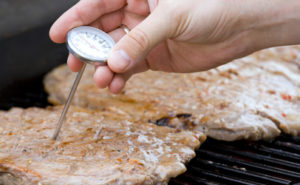 Food Safety & Info.
Food Safety & Info.
Below are some frequently asked questions. If you have a question that is not answered here, please contact us at (979) 776-5685.
For more facts and information on food safety, please visit the USDA’s Website.
Safe Temperatures for Cooking Meat:

Q. What is a safe temperature to which ground beef should be cooked?
A. Cook all raw beef, pork, lamb, and veal steaks, chops, and roasts to a minimum internal temperature of 145 °F as measured with a food thermometer before removing meat from the heat source. For safety and quality, allow meat to rest for at least three minutes before carving or consuming. For reasons of personal preference, consumers may choose to cook meat to higher temperatures. A consumer would not be able to determine if a roast that was pink in the center had reached the safe temperature of 145 °F without a food thermometer.
Q. At what temperature should poultry be cooked?
A. FSIS recommends cooking whole poultry to a safe minimum internal temperature of 165 °F as measured using a food thermometer. If poultry is stuffed, the center of the stuffing must reach 165 °F. Only by verifying the internal temperature of both the bird and the stuffing with a food thermometer can a consumer be sure the product has been thoroughly cooked.
Q. At what temperature should pork be cooked?
A. Cook all raw beef, pork, lamb, and veal steaks, chops, and roasts to a minimum internal temperature of 145 °F as measured with a food thermometer before removing meat from the heat source. For safety and quality, allow meat to rest for at least three minutes before carving or consuming. For reasons of personal preference, consumers may choose to cook meat to higher temperatures. A consumer would not be able to determine if a roast that was pink in the center had reached the safe temperature of 145 °F without a food thermometer.
Q. At what temperature should casseroles be cooked?
A. Casseroles and other combination dishes must be cooked to 165 °F as measured with a food thermometer. These dishes are traditionally composed of cooked foods and then heated to combine flavors. Pathogenic bacteria could survive, however, if the meat or poultry component of a casserole was merely “browned” and the casserole was not subsequently heated thoroughly, especially if the dish was assembled in advance and refrigerated. Only by using a food thermometer could a consumer be sure it had been heated to a safe temperature.
Optimal Temperatures for Storing Meat:
Q. At what temperature should ground beef be stored?
A. Optimum temperature is 28°-32° F.
Q. At what temperature should poultry be stored?
A. Optimum temperature is 30°– 32° F.
Q. At what temperature should pork be stored?
A. Optimum temperature 28° – 35° F.
Freezer and Refrigerator Temperatures for Food Storage:
Q. What is a safe temperature for a freezer?
A. Properly handled food stored in a freezer at 0 °F will be safe. Freezing keeps food safe by slowing the movement of molecules, causing bacteria to enter a dormant stage. Once thawed, these bacteria can again become active and multiply to levels that may lead to foodborne illness. Because bacteria on these foods will grow at about the same rate as they would on fresh food, thawed foods should be handled as any other perishable food.
Q. What is a safe temperature for a refrigerator?
A. A temperature of 40 °F should be maintained in the refrigerator. In contrast to freezer storage, perishable foods will gradually spoil in the refrigerator. Spoilage bacteria will make themselves known in a variety of ways. The food may develop an uncharacteristic odor, color and/or become sticky or slimy. Molds may also grow and become visible. Bacteria capable of causing foodborne illness either don’t grow or grow very slowly at refrigerator temperatures. An appliance thermometer should always be used to verify that the temperature of the unit is correct.
For more information, see the below link.
https://www.fsis.usda.gov/wps/portal/fsis/topics/food-safety-education/get-answers/food-safety-fact-sheets/safe-food-handling
